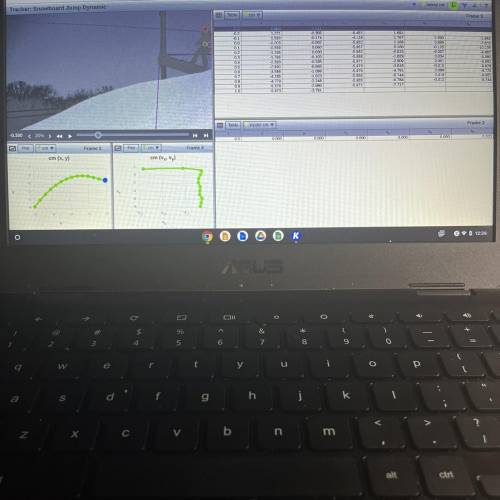Please help!! giving have not been able to find help!
Task 3
Modeling the Snowboarder's Mot...

Physics, 07.02.2022 01:00, zaygonegraduate
Please help!! giving have not been able to find help!
Task 3
Modeling the Snowboarder's Motion
In this kinematics unit activity, you won't use forces, but just describe the snowboarder's position over time. An analytic model is designed to do just
that.
You have traced the motion of the snowboarder using his center of mass as the point of reference. Now, consider the snowboarder as a whole and try
to model his motion mathematically.
With Tracker, you can create either an analytic particle model or a dynamic particle model for the snowboarder. An analytic particle model helps trace
the motion using the mathematical expressions for the positions of the object in motion. In a dynamic model, you set the initial conditions, like position
and velocity, and then you mathematically define the forces acting on that system.
Before creating the analytic model, though, you'll need to figure out how the x and y positions vary with time. You'll need mathematical expressions for
this to build your model. Answer the following questions to figure that out
Part A
The general kinematic equations of motion for horizontal displacement can be simplified significantly for this motion. Write the simplified
equation for x in this case. Explain how you have been able to simplify it from this general displacement equation:
Part C
Now, to get numerical equations for x and y, you'll need to know the initial values (at time t = 0) for some velocities and accelerations. On the Table
below the video:
• Select cm as the mass measurement set to display.
. Click the Table label and check all x and y displacement and velocity data: x y, vx, and yy. Then click Close.
Now rewrite the displacement equations from Part A and Part B above by substituting in the x and y velocity values from time t= 0 and also using
the theoretical value of acceleration of gravity. Write them out below.
Part D
Describe in what way the position of the modeled point varies from the center of mass point. Specifically, in the last frame, in what direction does
it lie from the center of mass point?
Assuming the variation is due to small inaccuracies in the initial velocity values in the table, how would you have to modify the initial vx and Vy
values to get closer to the observed motion?
Now, refer to the Tracker Help to see how to define an analytic model in the Model Builder. There, you'll need to:
• Create an Analytic Particle Model
• Select a color for this measurement different from the four other measures (like a bright blue)
• Enter the mass of the snowboarder in kg. (See the first frame of the video for that information.)
• Enter the initial time. Since we're modeling the projectile motion part of the run, begin with time t=0.0.
• Enter the expressions you developed in (c) above for the horizontal and vertical displacements. Note that you'll need to use symbols similar
to those used in a spreadsheet for multiplication (*), division (/), and exponents (^).
After you create your analytic model, run the video. Due to the short time intervals in this video (0.1 seconds) and the difficulty of measuring
closer than a couple of centimeters for any point on the snowboarder's body in the video, the instantaneous velocities recorded in the table for
any given point might be off by as much as 10 centimeters per second (0.1 meters/second). This is really just a measurement variation of one
centimeter on the snowboarder's body in the 0.1 second time interval. If a point measurement is off by one or two pixels in this video, you'll see
that much variation in instantaneous velocity for an individual point.
Part E
Try some slightly different values for both Initial velocities (V, and vy) and test them against the center of mass point by running the video. Your
test values should not differ from the table values by more than 0.100 meters/second. Once you are satisfied with your model, record model
values and expressions in the table below.
Modeled Variable-
Expression -
(Initial) Vx
(Initial) Vy
Parameter: m
Initial value: t
Position function: x
Position function:y
Part F
Imagine you were a sportscaster at the Olympics. Youd created a mathematical model similar to the one you just did. Imagine that you had a
computer program that could do an instantaneous analysis of video motion using that model. How could you use it in your sportscast?


Answers: 3
Other questions on the subject: Physics



Physics, 22.06.2019 09:00, edgarsandoval60
Agroup of students is studying convection currents. they fill two identical balloons with the same amount of helium. one balloon is placed in a freezer and the other in an area with warm air. after 10 minutes, the balloons are released from a height of 1 meter. which of the following do the students most likely observe? question 2 options: the balloons rise at the same rate. both balloons are the same size. the ballons both rise. the cold ballon is larger than the warm balloon. the cold balloon expands and rises. the warm balloon shrinks and sinks. the warm balloon expands and rises. the cold balloon shrinks and sinks.
Answers: 3
Do you know the correct answer?
Questions in other subjects:

Mathematics, 17.12.2020 01:00



Mathematics, 17.12.2020 01:00

Mathematics, 17.12.2020 01:00


Mathematics, 17.12.2020 01:00



Mathematics, 17.12.2020 01:00






